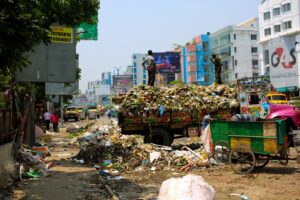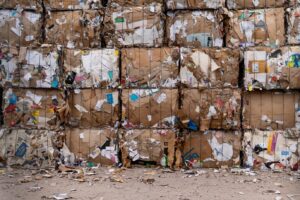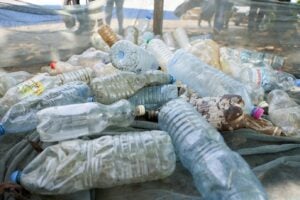July 28, 2022 / by FMP
Filed Under: Uncategorized
 Waste Removal In Foreign Countries
Waste Removal In Foreign Countries
Call out tourism, the increase in population, or the waste management infrastructure. The truth is that the world is converting into a dumpster. This problem is not unique to any country or city; waste removal has become a universal problem. Soda cans are crushed and kicked to the curb, plastic water bottles are casually tossed in the trash, and cigarette butts are flicked on the ground without a second thought. This wastefulness has caught up to us, and now we are struggling to find ways to manage the waste that we have created.
Since the environment is feeling burnt from our wastefulness, many countries have been working to improve their waste removal infrastructure. Some cities have started to offer recycling pick-up, others are working on waste-to-energy plants, and some are even banning certain types of plastic. While these steps are a decent start, there is still a lot of waste that is ending up in landfills.
We will highlight a few best strategies that countries worldwide use to manage waste. Hopefully, by the end of this blog post, you will have a few more ideas of how you can help reduce waste in your community.
Colombia’s Recycling Solution:
Columbia’s waste removal strategies have turned necks in the waste management world. With one of the most ambitious waste removal plans, they are setting a high standard for other countries to follow. And honestly, with 28,800 tons of solid waste from the main cities like Bogota, it’s no wonder they need to be so ambitious.
ECOBOT is their revolutionizing reverse vending machine that eats your waste and gives you a reward in return. The device is fed with PET bottles and is placed in prominent public areas like parks, malls, and plazas. In return for your waste, you receive a reward that can be used at local businesses. From movie tickets to discounts on coffee to free public transportation, there are a variety of rewards that you can receive.
The collected waste goes to the recycling plant instead of becoming a pile of waste in a landfill. Not only does this reduce waste, but it also provides jobs for those running the recycling plant and manning the ECOBOT machines.
Uganda is Dealing with Waste Removal in a Unique Way:
Uganda is taking waste removal into their own hands…literally. The mastermind behind Uganda’s artistic and community-benefitting waste removal strategy is artist and environmentalist Ruganzu Bruno. He turns waste into beautiful art dotted around Kampala, the capital city of Uganda.
Bruno’s Eco-Art Uganda project focuses on transforming waste into artistic swings and board games for an amusement park for children in Kampala’s slums. The materials used for the project are all waste that would otherwise be littering the streets. From old tires to plastic bottles, Bruno has found a way to turn waste into something beautiful and functional.
The 30-year-old artist hopes to expand his project to 100 such amusement parks in various areas of Uganda. He takes help from the locals, providing employment and teaching them new skills. Who could have thought the key to waste removal was hidden in plain sight all along?
 Trade Trash for Healthcare in Indonesia:
Trade Trash for Healthcare in Indonesia:
Apart from environmental damages, waste accumulation also causes several health hazards. You could contract bacterial infections like cholera, diphtheria, and dysentery from coming in contact with waste.
To keep the waste off the streets and provide healthcare for those in need, Indonesia has developed an innovative waste removal solution. Dr. Gamal Albinsaid, a 32-year-old doctor, has started a waste bank in Indonesia where people can bring their waste in exchange for free healthcare.
He noticed a link between general health and that less than half of the 55,000 tons of trash generated in Malang City, Indonesia, gets collected. He created Garbage Clinical Insurance, which trades garbage for medical services and pharmaceuticals using garbage as currency.
Plastic Streets in India:
India‘s huge population of about 1.4 billion people creates a lot of waste. We are talking about a whopping 62 million tons of waste annually. 70 percent of this waste gets collected, whereas the rest is dumped on the streets, rivers, and other places.
In an attempt to make waste removal more efficient, a Chemistry professor, Rajagopalan Vasudevan, came up with a solution. He developed a process of laying waste plastic on bitumen while constructing roads. Usually, asphalt is used for constructing roads, a mixture of bitumen and gravel. However, waste plastic can also be used as a binding agent.
This method has been employed on several roads in India with great success. It helps get rid of waste and makes the roads stronger and more durable. His method also gives access to a cheaper than asphalt pavement material.
In a country where waste removal is a daunting task, Professor Vasudevan’s method is nothing short of revolutionary.

China’s “Green Fence” Policy:
China is the world’s leading producer of waste. In 2017, China produced about 210 million tons of waste, which accounted for nearly 15 percent of the global solid waste.
In an attempt to get a handle on the waste problem, China implemented the “Clean Production Action Plan.” This policy, also known as the “Green Fence” policy, was introduced in 2013. The policy aimed to reduce waste imports by inspecting waste and recycling facilities.
As a result of this policy, the import of waste into China decreased by 99 percent. This had a ripple effect worldwide as other countries were now left with nowhere to send their waste.
While the “Green Fence” policy successfully reduced waste imports, it also created some problems. For instance, countries like the United States now have to find new ways to dispose off their waste.
The “Green Fence” policy was a necessary step in the right direction, but it also highlighted the need for a more sustainable and long-term solution to waste removal.
Conclusion:
Waste removal is a global problem that needs to be addressed urgently. The methods described above are just a few innovative solutions to address this problem. With the right attitude and policies, waste removal can be made more efficient and sustainable.
Remember, we are all aiming for a zero-waste future. Let’s do our part to make that happen.
Read more: The Future of Landfills
Electric Cars and the Environmental Impact
The Guardian: Where Does Your Plastic Go? Global Investigation Reveals America’s Dirty Secret
